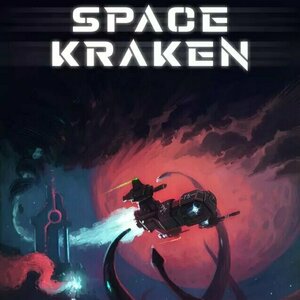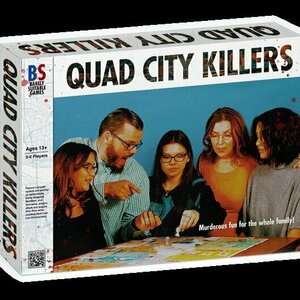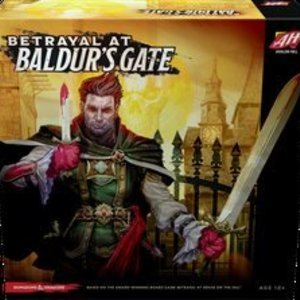
Betrayal at Baldur's Gate
Tabletop Game
Description from the publisher: The shadow of Bhaal has come over Baldur's Gate, summoning...
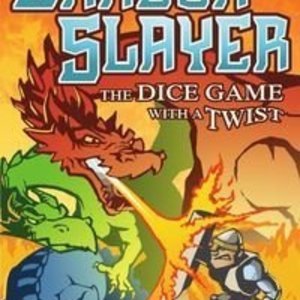
Dragon Slayer
Tabletop Game
You are the world's most fearless dragon slayers, competing to be crowned the master slayer. Your...
Boardgames DiceGames PressYourLuckGames DragonGames

Smash Monster Rampage!
Tabletop Game
A huge monster, taller than the highest skyscraper, is attacking your city! Work together to...
Boardgames MonsterGames KaijuGames GodzillaGames
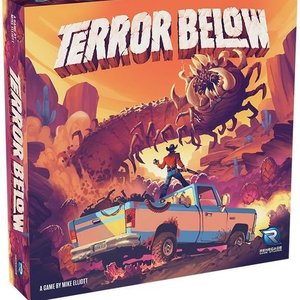
Terror Below
Tabletop Game
Terror Below is a game of government experiments gone wild in the Nevada desert. The faster you...
2019Games RenegadeGames MoviesINtoGames TremorsGame
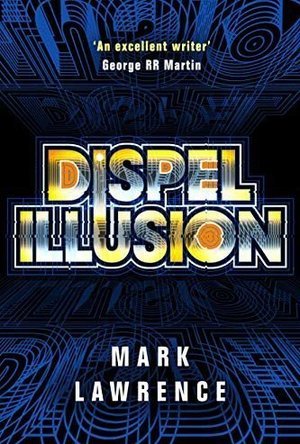
Dispel Illusion
Book
Sometimes being wrong is the right answer. Nick Hayes’s genius is in wringing out the...
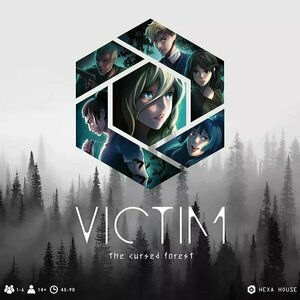
Victim: The Cursed Forest
Tabletop Game
Victim, a horror board game that lets players help each other to find a way out by cooperatively...
Purple Phoenix Games (2266 KP) rated Space Kraken in Tabletop Games
Jul 22, 2021
Disclaimer: We were provided with a demo version of Space Kraken. The gameplay is that of the full version, just with a shorter storyline and fewer variations. What you see pictured below may not be identical to what will be received in the finalized version. Also, the game can be played solo or with multiple players – this preview will be covering the solo-only mode of play. I do not intend to cover the entire rulebook, but rather provide an overview of the mechanics and gameplay. -L
Space Kraken is a sci-fi dungeon crawler encompassed in a spiral-bound book. The only additional components you need are 2d6, 1d20, and a pencil with a decent eraser. To start a new game, you will first get set up for the campaign. There are 6 Flights (game modes) to choose from and you select one with which to play. Different Flights affect the start of game conditions, which will affect the overall gameplay. For example, one Flight might offer bonuses to your ability scores, while another could give you stronger weapons right from the start. Once you’ve selected your Flight, you will then set up your Story Lines. These will help dictate the story of your overall campaign, and will be influenced by your strategies and decisions along the way. From crucial plot points to opportunities for ‘side quests,’ the Story Lines work to drive the narrative. The next step is to create your crew. You choose 3 heroes to start with, and will ‘build’ them by giving them attributes, equipment, and skills. The specific parameters are detailed in the rules. After the crew is created, the game is officially ready to begin!
A game of Space Kraken is played over a series of turns, broken down into 5 phases. The first phase of a turn is to Activate Story Lines. These are tracked across a series of 4 tables of coordinates. Find the coordinate on the appropriate table for your Story Line, and proceed as necessary. Some coordinates link to Events that require you to make decisions, roll dice, execute commands, while other coordinates will just link to a new coordinate to be used next turn. Once you have Activated and resolved all your Story Lines for the turn, the game moves to the Ship Construction phase. At the start of the game, you will most likely skip this phase, but as the game progresses and you earn funds, you will be able to upgrade and modify your spaceship during this part of the turn.
The third phase of a turn is to Perform Your Own Action. You can choose to either: Initiate Space Flight, Land at an Already-Discovered Location, or Activate a Story Line Again. Initiating space flight gives you the opportunity to explore different regions of space, discover/explore new locations, and sometimes even engage in space combat. You could choose to land at an already-discovered location, which allows you to visit many of the ‘dungeons’. Or you can activate a story line again, which lets you advance one of your story lines forward. After you perform your own action, phase 4 begins – Quick Visit a Shop, Ammo Dealer, or Quest Master. This one is pretty self-explanatory. You can trade or purchase goods from locations you have visited, or you could visit the Quest Master for ‘side quests.’ And then finally the last turn phase is Quest Timer. Any quests you have that were not advanced in this turn get a mark for Lost Time – after 5 marks they are erased! So prioritize wisely when it comes to your quest completion. A new turn now begins, following the same phase structure as detailed above. The game continues until either you have defeated the Space Kraken, or your entire crew and/or ship has perished.
At first glance, Space Kraken is kind of daunting and intimidating. There’s a bit of a learning curve as you figure out this gameplay system before you can really dive in to play. That being said, once you understand how the different aspects work – Space Flight, Combat, Story Lines, Dungeon Exploration, etc. – it will all click together. This isn’t a game you just pick up and decide to play on a whim, it’s one that takes focus and dedication to complete a play-through. Just something to keep in mind! As with most campaign-style games, the question of replayability is always in the forefront, and I think that Space Kraken really handles it very well. The Story Lines alone offer a range of variability that ensures no two games will be the same. How you build your crew and ship could influence decisions made with regards to Story Lines, which in turn leads you down a unique path with a plethora of opportunities. The mechanic for generating new locations to explore (the dungeon crawling element) also provides a variety of places to explore, alien races to interact with, and physical elements like atmosphere. The chances for generating the exact same location more than once are pretty slim, I would say. All of these elements just add to the replayability of Space Kraken and keep it fresh and unique for each play-through.
Guiding the overall gameplay are your dice. Some Story Lines offer 2 solutions, and you will roll the dice to see with which one you end up. To generate a new location, you roll the dice a number of times, looking at the corresponding tables in order to build the map for your current foray into space. Obviously, combat, either in ships or on the ground, will use dice to help dictate the flow of battle and the outcomes of said fights. That is how you can get so much replayability from this game – dice rolling. The range of Story Lines and locations coupled with dice rolls really create a one-of-a-kind gameplay experience, no matter how many times you play through. You’ll never play the same game twice….well, unless your dice results are the exact same for every roll as they were the previous game.
Let’s touch on components for a minute. As stated above, this is only a demo version of the game. That being said, the game is encompassed in a spiral-bound book, and that is what the complete game will be like too. The only things you need to play besides the book are a couple of d6, a d20, and a pencil! I think it’s neat that so much gameplay can be packed into a single book. Between sessions if you’re not able to leave the book on your table, simply mark your page, fold everything back into the book, and you’re good to go! What do I mean by fold everything back into the book? Several of the pages in this game have fold-outs of additional materials to be pulled out when necessary. I really like that if you don’t currently need a page, it doesn’t need to be showing. It helps keep the game a little more focused, visually, in my opinion. My only complaint is that a couple of times, a fold-out section may overlap another fold-out section, meaning that you have to end up flipping pages anyway. A small price to pay for an all-in-one game book! My other qualm is that as you play, you will write in the book. After you complete a play-through, you can go back and play again – just erase everything and start over. My concern is that with repeated erasing on the pages, the quality will wear down and could be unusable after a certain number of plays. Maybe that’s not a problem for other gamers, but that is something that jumped into my head when playing this.
Overall thoughts? Space Kraken is pretty cool. There is a bit of a learning curve as you delve into the new system, but once you’ve got the general mechanics/gameplay down, the rest is pretty straight-forward. The fact that the entire game is encompassed in one book is a neat element too. It allows you to ‘save’ your progress and come back to it without the hassle of setting up a million components. Having only played the solo version of the game, I’m curious to see how the multiplayer side works, so that may just be my next play-through! If you’re in the market for a campaign-style game, without requiring tons of table space and eons of time to play through, consider checking out Space Kraken. It successfully funded on Kickstarter and the late pledges are now open!
Purple Phoenix Games (2266 KP) rated Quad City Killers in Tabletop Games
Jan 30, 2021
Quad City Killers (or QCK) is a competitive game of moving around a map and eliminating points of interest by using resources from hand. Or, in actual gamespeak, stalking the streets of the QC murdering prey by using weapons, modifiers, and scenario cards to adjust the winds of chance for success.
DISCLAIMER: We were provided a prototype copy of this game for the purposes of this review. These are preview copy components, and I do not know for sure if the final components will be any different from these shown. Also, it is not my intention to detail every rule in the game, as there are just too many. You are invited to download the rulebook, back the game through the Kickstarter campaign ending March 5, 2021, or through any retailers stocking it after fulfillment. -T
To setup place the large map (an actual map that you would find in your grandparents’ Oldsmobile) on the table. Shuffle the Prey deck and the Resources deck separately and place them in their spots on the map. Place the Heat tokens on the lowest space in each city. Keep the three dice nearby for all players’ use. Each player will choose a serial killer profile mat, a color of skull mover token, and Dexterity token to track progress. Each player will also draw five Resource cards from the deck and one Prey card to place on the board in a city along with their skull mover token. The game may now begin!
The first thing each player will do on their turn is perform a Hunt action by drawing and placing on the map the top card of the Prey deck. Most Prey are color-coded to be placed in a matching city, but some are not and may be placed in any city on the map. Next, the player may perform any three actions from the following: Hunt, Travel, Attack, Scenario, Discard.
Hunt works the same as the action performed at the beginning of each turn: draw a Prey card and place it on the board. In order to Travel to a new city the player will roll the dice. For a value of 1+ the player may travel to any city within their current state. For a value of 2+ the player may cross the Old Man to the other side (preferably using the half-finished under-construction new I-74 bridge). A player may play a Scenario card from their hand, and if it shows the Action icon they will spend one of their three actions to play and resolve it. A player may also choose to Discard two cards from their hand and replace them with cards drawn from the Resource deck for an action.
The game would not be named Quad City Killers if killing was not involved somehow. As the final option of action to be taken on a turn a player may choose to Attack a Prey card in the same city in which the player’s token resides. To Attack, the player will consult the Prey card’s printed defense value for their target number. The player will then combine any Resource cards they may have in hand with their current Dexterity score (tracked on their player mat) and the roll of the three dice. If the end result matches or exceeds the Prey’s defense value the Prey is eliminated. The player collects the Prey card for a trophy and for its Notoriety value (victory points) at game end.
Resource cards come in different flavors: Weapons, Scenarios, Modifiers, and Ego. Weapon cards are just that: weapons. They may be used once for an attempted kill and then are discarded. Scenarios may mess with opponent tactics, allow players to move Prey cards to different cities, or other various activities. Modifiers may also adjust the current Advantage enjoyed by the player or be played on a Prey card to lower its defense value. Ego cards (and also some Weapon cards) will have an M.O. icon on them and may be placed directly on the player mat. These M.O. cards offer a once-per-turn advantage for the player and are very powerful.
The game continues in this fashion of taking turns moving around the map, hunting prey and killing them, and using Resources to adjust the difficulty of the murder. Once a player has increased their Dexterity token to the end of the track the game ends and the players count up Notoriety values (VP) of all slain Prey cards to arrive at the greatest serial killer the Quad Cities has ever seen (which, being from the QC would be saying something – I don’t remember ANY serial killers here).
Components. Okay, this was a super cool game to open up in the mail. Inside the mailer box was this strange Evidence bag. I have never seen an Evidence bag in my life so I wasn’t quite sure what was inside. But when I opened it and saw it was the components for the game I immediately smiled at how cool that was to include. It certainly made an impression. Now, please remember that this is a prototype copy of the game, and the finished version will have slightly different and improved components. That said, what we were provided is very close to final quality (and better than some games I have in my collection!). The cards are all fine, the dice are dice, and the tokens are well-designed and interesting. The best component, for me, is the excellent map of the QCA. It folds/unfolds like an old map would (prior to GPS) and has my hometown right on it! Luckily I live in a suburb(?) of the Metropolitan QCA so my house is nowhere to be found on the map, but it is very strange and exciting to play a game on a map of your home.
The game as a whole is pretty good. Though the estimated time to finish the game is quoted at 90-180 minutes (and maybe with the full compliment of players), my plays with my wife were well under an hour each time. We both enjoyed the game quite a bit once we got over the whole premise of it. The theme is obviously dark and macabre, but in the end it is still just a game.
I felt very engaged for every second of the game as I watched my wife nail roll after roll during her Attack actions while I fail to manage even a roll of 2+. Yes, I am unable to roll 2+ on THREE DICE. My issues aside, the dice really do add a layer of chance (obv) that all the accounting and cardplay just will not cover. I like that. I like chance in my games, even when it goes against me. I also enjoyed having five actions from which to choose three on my turn, but I could also use the same action all three times if I wished. More options is usually good, and having more than one obvious route or strategy is a huge bonus for me.
All in all I really did enjoy this game quite a bit. Again, the theme may be off-putting for some, and I will not play this game with my children until they are probably older than the suggested 13+ but I can definitely see myself breaking this out with a group of adults who are itching for something completely different from what they are accustomed to playing. If you are like me and need something just absolutely jarring in your collection, I urge you to take a look at Quad City Killers, on Kickstarter now until March 5, 2021. Just stay out of Milan (pronounced MY-lin) and we will be fine.
